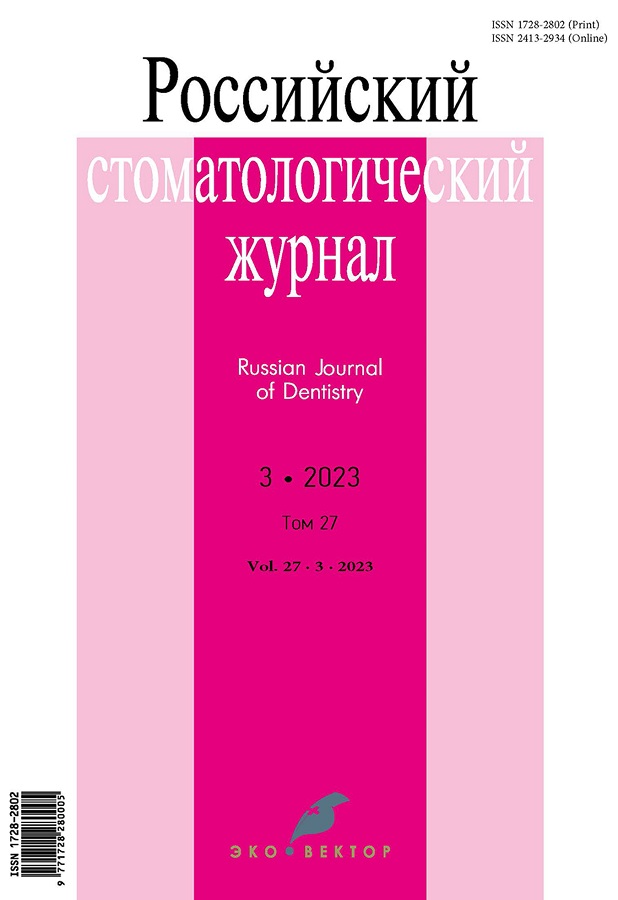Analysis and evaluation of the effectiveness of autotransplantation of teeth
- Authors: Dulov F.V.1,2, Gurkin R.B.2, Derbentsova E.S.1,2, Budanova U.V.3
-
Affiliations:
- Ryazan Regional Clinical Hospital
- Prime Dental Clinic
- Ryazan State Medical University
- Issue: Vol 27, No 3 (2023)
- Pages: 193-200
- Section: Clinical Investigations
- Submitted: 29.12.2022
- Accepted: 06.06.2023
- Published: 23.08.2023
- URL: https://rjdentistry.com/1728-2802/article/view/120088
- DOI: https://doi.org/10.17816/dent120088
- ID: 120088
Cite item
Abstract
BACKGROUND: The successful technique of autotransplantation of wisdom teeth as an additional method of restoring dentition in patients with impending removal of the first or second molars is relevant.
AIM: To assess the effectiveness of autotransplantation of wisdom teeth instead of an extracted tooth (first or second molars).
METHODS: The study analyzed 30 patients aged 22–38 years who were treated at the Ryazan Regional Clinical Hospital (Department of Maxillofacial Surgery) and Prime Dental Clinic LLC between January 2016 and August 2022 and underwent autotransplantation of a tooth. We evaluated the mobility of the replanted teeth, nociceptive sensitivity, depth of the dentoalveolar furrow, and computed tomography (CT) results. To assess the effectiveness of the technique, the Periotest M device, periodontal chart, and photoprotocol were used.
RESULTS: During the study, the survival rate of the replanted teeth was 100%. The depth of the dentoalveolar furrow reached normal values in 93% of clinical cases and mobility within normal limits in 87% of cases. On CT, no signs of ankylosis and inflammation of bone tissue in the area of the transplanted teeth were observed in all the studied patients.
CONCLUSION: Autotransplantation of a tooth is an effective and well-predicted technique that allows restoring the integrity of the dentition in patients indicated for the removal of the first or second molars.
Keywords
Full Text
About the authors
Filipp V. Dulov
Ryazan Regional Clinical Hospital; Prime Dental Clinic
Author for correspondence.
Email: bfilq@rambler.ru
ORCID iD: 0000-0002-6753-271X
SPIN-code: 8795-6818
Russian Federation, Ryazan; Ryazan
Roman B. Gurkin
Prime Dental Clinic
Email: gurkin.roma@yandex.ru
ORCID iD: 0000-0002-2360-9850
Russian Federation, Ryazan
Ekaterina S. Derbentsova
Ryazan Regional Clinical Hospital; Prime Dental Clinic
Email: Kulaeva.doc@gmail.com
ORCID iD: 0000-0002-9179-244X
MD, Cand. Sci. (Med.)
Russian Federation, Ryazan; RyazanUlia V. Budanova
Ryazan State Medical University
Email: juliya16.05@icloud.com
ORCID iD: 0000-0001-9771-8323
student
Russian Federation, RyazanReferences
- Shareef RA, Chaturvedi S, Suleman G, et al. Analysis of tooth extraction causes and patterns. Open Access Maced J Med Sci. 2020;8(D):36–41. doi: 10.3889/oamjms.2020.3784
- Siddiqui HK, Siddiqui S, Rehan F, Ali SA. Causes, frequency & pattern of dental extraction: An analysis of 400 patients reporting to Oral & Maxillofacial Department of Baqai Dental College, Karachi. Journal of Peoples University of Medical & Health Sciences. 2015;5(1):18–22.
- Caldas AF, Marcenes W, Sheiham A. Reasons for tooth extraction in a Brazilian population. Int Dent J. 2000;50(5):267–273. doi: 10.1111/j.1875-595X.2000.tb00564.x
- Utesheva AY. Zuby «mudrosti» – «to be or not to be…»? Bulletin of Medical Internet Conferences. 2017;7(10):1504–1506. (In Russ).
- Vdovenko KD, Narbekova ER. Chastota vstrechaemosti patsientov s patologiei 8-kh zubov. Bulletin of Medical Internet Conferences. 2017;7(11):1576. (In Russ).
- Galstjan SG. Optimizacija metodov ortodonticheskogo lechenija pacientov s deficitom mesta v zubnom rjadu [dissertation]. Saint Petersburg; 2020. Available from: https://www.volgmed.ru/uploads/dsovet/thesis/3-945-galstyan_samvel_galustovich.pdf (In Russ).
- Nikolaev AI, Tsepov LM. Fantomnyi kurs terapevticheskoi stomatologii. Moscow: MEDpress-inform; 2017. (In Russ).
- Andreasen JO, Paulsen HU, Yu Z, et al. A long-term study of 370 autotransplanted premolars. Part I. Surgical procedures and standardized techniques for monitoring healing. Eur J Orthod. 1990;12(1):3–13. doi: 10.1093/ejo/12.1.3
- Sirak SV, Shchetinin EV, Dilekova OV, et al. Gistokhimicheskie izmeneniya v tkanyakh parodonta posle autotransplantatsii zubov. Medical News of North Caucasus. 2016;11(1):99–103. (In Russ).
- Tsukiboshi M. Autotransplantation of teeth: requirements for predictable success. Dent Traumatol. 2002;18(4):157–180. doi: 10.1034/j.1600-9657.2002.00118.x
- Zedgenidze AM. Autotransplantacija zubov u vzroslyh pacientov [dissertation]. Moscow; 2021. Available from: https://nmic1.cniis.ru/downloads/dis/dis_Zedgenidze.pdf (In Russ).
- Kang J-Y, Chang H-S, Hwang Y-C, et al. Autogenous tooth transplantation for replacing a lost tooth: case reports. Restor Dent Endod. 2013;38(1):48–51. doi: 10.5395/rde.2013.38.1.48
- Andreasen JO, Paulsen HU, Yu Z, et al. A long-term study of 370 autotransplanted premolars. Part II. Tooth survival and pulp healing subsequent to transplantation. Eur J Orthod. 1990;12(1):14–24. doi: 10.1093/ejo/12.1.14
- Andreasen JO, Paulsen HU, Yu Z, Schwartz O. A long-term study of 370 autotransplanted premolars. Part III. Periodontal healing subsequent to transplantation. Eur J Orthod. 1990;12(1):25–37. doi: 10.1093/ejo/12.1.25
- Andreasen JO, Paulsen HU, Yu Z, Bayer T. A long-term study of 370 autotransplanted premolars. Part IV. Root development subsequent to transplantation. Eur J Orthod. 1990;12(1):38–50. doi: 10.1093/ejo/12.1.38
- Andreasen JO. Relationship between cell damage in the periodontal ligament after replantation and subsequent development of root resorption. A time-related study in monkeys. Acta Odontol Scand. 1981;39(1):15–25. doi: 10.3109/00016358109162254
- Tsukiboshi M. Autogenous tooth transplantation: a reevaluation. Int J Periodontics Restorative Dent. 1993;13(2):120–149.
- Gioeva JA, Matveeva MN. Autogenic tooth transplantation. Ortodontiya. 2010;(1):44–52. (In Russ).
- Malan’in IV, Glushchenko MA. Novyi sposob posttravmaticheskoi autoreplantatsii zubov. Sovremennye naukoemkie tekhnologii. 2004;(4):41–43. (In Russ).
Supplementary files

















